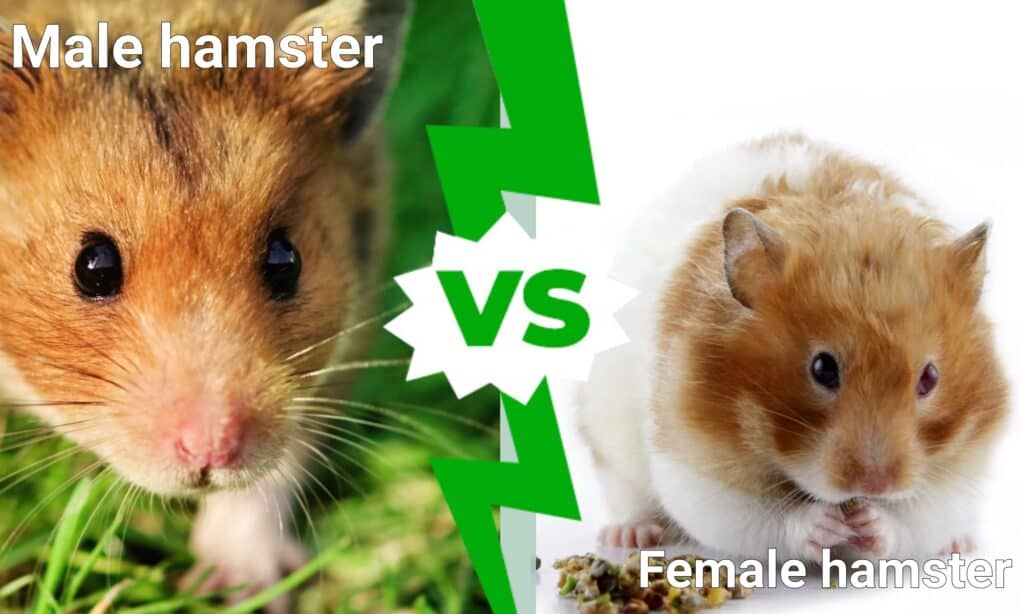Hamsters are low-key pets that fit into everyone’s lifestyle or living situation. But there is a lot that goes into this seemingly uncomplicated pet! The first is the choice of male vs female hamsters, and to make that choice, you need to know the difference.
But what differences are there between male and female hamsters? Their physical and behavioral differences really matter when deciding to add a hamster, or two, to the family.
Key Differences between Male and Female Hamsters

The major differences between male and female hamsters are their physical characteristics, temperament and behavior. The easiest way to tell if a hamster is male or female is by looking at the anogenital distance. This term refers to the space between the genital opening and the anus. In female hamsters, that space is much smaller than in males.
Male vs Female Hamster: Physical Differences

Male and female hamsters can appear nearly identical, and differences can vary by species.
©iStock.com/Conny V
While male and female hamsters may seem identical at first, there are some key physical differences. The most accurate way to tell is by the anogenital distance. However, another indicator is that only female hamsters have nipples.
There are some key indicators for sex that vary by species as well that can help you tell hamsters apart. For example, Syrian hamsters are the easiest to identify males from females because sexual characteristics are highly visible.
Identifying Male Hamsters By Physical Characteristics
In addition to a longer anogenital distance and lack of nipples, male hamsters can be identified by other physical characteristics. Male hamsters have more elongated, and rounder hind ends. After 4 weeks, male genitalia is also visibly apparent, though testicles may retract at times. Males have thicker and fuller coats and may require grooming.
Other physical characteristics of male hamsters vary by species. Male Dwarf hamsters can be identified by the visible and much larger scent gland on the middle of the belly. Male Dwarfs also have more tapered hindquarters and tend to be much larger.
In male Chinese hamsters, the longer and rounder hindquarters are much more apparent compared to other species.
Identifying Female Hamsters By Physical Characteristics
Female hamsters have a much shorter anogenital distance and nipples as their main identifying features. However, there are other ways to identify a female hamster based on physical characteristics. Female hamsters will also produce a musky and unpleasant smell every 4 days when they go into heat.
Except for the Dwarf hamster, females tend to be larger than males. Females \have a thinner coat of fur. Other physical characteristics vary by species.
Male vs Female Hamsters: Temperament And Behavior Differences

Female hamsters are known to be more aggressive and territorial.
©iStock.com/MajaArgakijeva
Hamsters are low-maintenance pets and fit into most living situations. Like many other popular pets, male and female hamsters have key differences in behavior and temperament. To decide whether to adopt a male or female hamster, personality is key to selecting your new pet!
Male Hamster Temperament And Behavior
Male hamsters are more easygoing and friendly than females and are more open to being handled. In general, they are calm and docile and do not display aggression when you reach into their space to pick them up. Male hamsters are the best choice for children, as they are more affectionate and enjoy being held more.
Female Hamster: Temperament And Behavior
Like rabbits, female hamsters are significantly more dominant than males and are much more territorial. Female hamsters are widely considered more difficult to handle and display aggression. Females are also known to bite more frequently when you reach into their enclosure to pick them up. For these reasons, female hamsters may not be the best option for children.
This is not to say a female hamster cannot be a good pet. Though owning a female requires more patience, they can be an excellent little companion!
About Having More Than One Pet Hamster

Both male and female hamsters are largely solitary animals.
©iStock.com/Manatchon
Hamsters are solitary animals that do not enjoy sharing their territory with others. Unlike guinea pigs or rabbits, most hamster species should never share an enclosure. There are a few species that can share an enclosure, such as the Roborovski and Winter White Dwarf species. In general, if you wish to adopt more than one hamster, they will each need their own space.
Female hamsters are extremely aggressive and territorial, especially toward other females. Male hamsters may be more docile, but they are equally aggressive when placed together. When two hamsters fight, the death of one or both is likely if left to continue. Additionally, both male and female hamsters will eat their own young.
Also, female hamsters go into heat every 4 days. Placing males and females in the same enclosure is inadvisable unless you are intending to breed them. Even in this case, they should be separated after mating as soon as possible. Female hamsters become much more territorial and aggressive when pregnant and after giving birth.
The photo featured at the top of this post is © COULANGES/Shutterstock.com
Thank you for reading! Have some feedback for us? Contact the AZ Animals editorial team.






